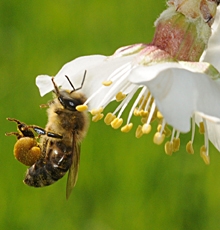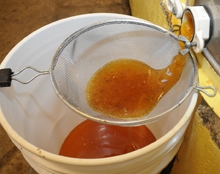That liquid gold called honey
If those pollen-packing honey bees were to board an aircraft, they’d be charged for their carry-on luggage.
Fortunately they don’t and they’re not.
And if we were a bee, we’d have to visit two million flowers to make a pound of honey.
Fortunately we’re not, and we don’t.
The honey bee, brought to America by the European colonists in the 1600s, will be celebrated on National Honey Bee Awareness Day, Saturday, Aug. 21, but this insect should be celebrated every day of the year.
Revered for her indispensable pollination services, she also provides us with that liquid gold we call honey. Wonderful, delectable, soothing honey.
“Honey is nature’s miraculous food,” write Ron Fessenden and Mike McInnes, co-authors of the 215-page book, Honey Revolution: Restoring the Health of Future Generations.
“The nutritional composition of honey, calorie for calorie, is closer to fruit than it is to table sugar, high fructose corn syrup or any other sweetener."
They call it “sunshine energy” and “nature’s soul food.”
Over at the Harry H. Laidlaw Jr. Honey Bee Research Facility, University of California, Davis, pop. 6 million (honey bees, that is), the faculty and staff call this insect simply “amazing.”
This week the UC Davis beekeepers are extracting honey — uncapping the combs with an electric knife, spinning the frames through the centrifugal-force honey extractor, and then gathering the flow of honey.
“It’s a sticky situation,” agreed staff research associate Elizabeth Frost, as Bryce Sullivan, a UC Davis senior majoring in biochemical engineering, and Brandon Seminatore, a UC Davis junior majoring in biochemistry and molecular biology, extracted honey — amid a few bee escapees.
The finished product is perfect for pouring on pancakes and waffles. The National Honor Board provided these recipes that kids of all ages love:
Honey Raspberry Citrus Slush
1-1/2 cups fresh orange juice
1/2 cup honey
2 tablespoons lemon juice
2 tablespoons lime juice
1-1/2 cups raspberries, fresh or frozen
1 cup crushed ice
Lemon or lime for garnish
In a blender, combine orange juice, honey, lemon and lime juices; mix until honey is dissolved. Add raspberries and ice; puree. Serve in beverage glasses garnished with a lemon or lime wheel. Makes six six-ounce servings.
Fruity Honey Yogurt Pops
1 cup fresh nectarines, pineapple or strawberries, chopped
1-1/2 cups plain yogurt
1/3 cup of honey
1 teaspoon vanilla
Eight 3-ounce paper cups and popsicle sticks or plastic spoons
In a blender, combine all ingredients; mix well. Pour evenly into eight paper cups; insert popsicle stick or plastic spoon in center of each. Freeze 4 hours or until frozen solid. Makes 8 pops.

Frame of Uncapped Honey

Sampling


